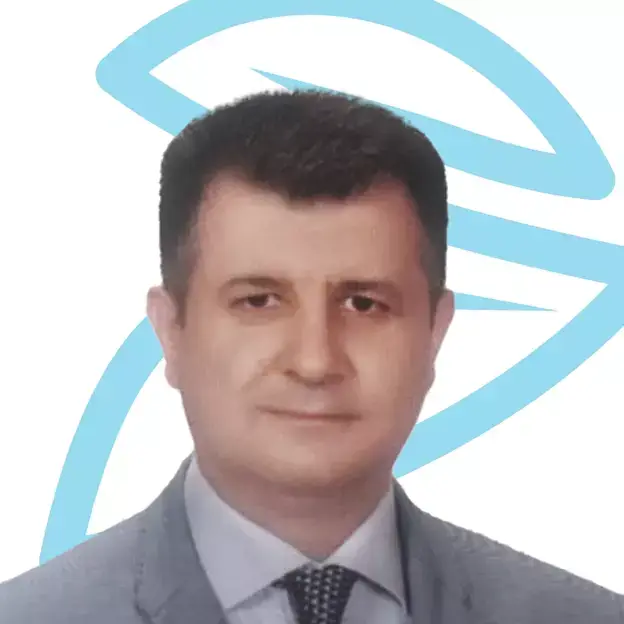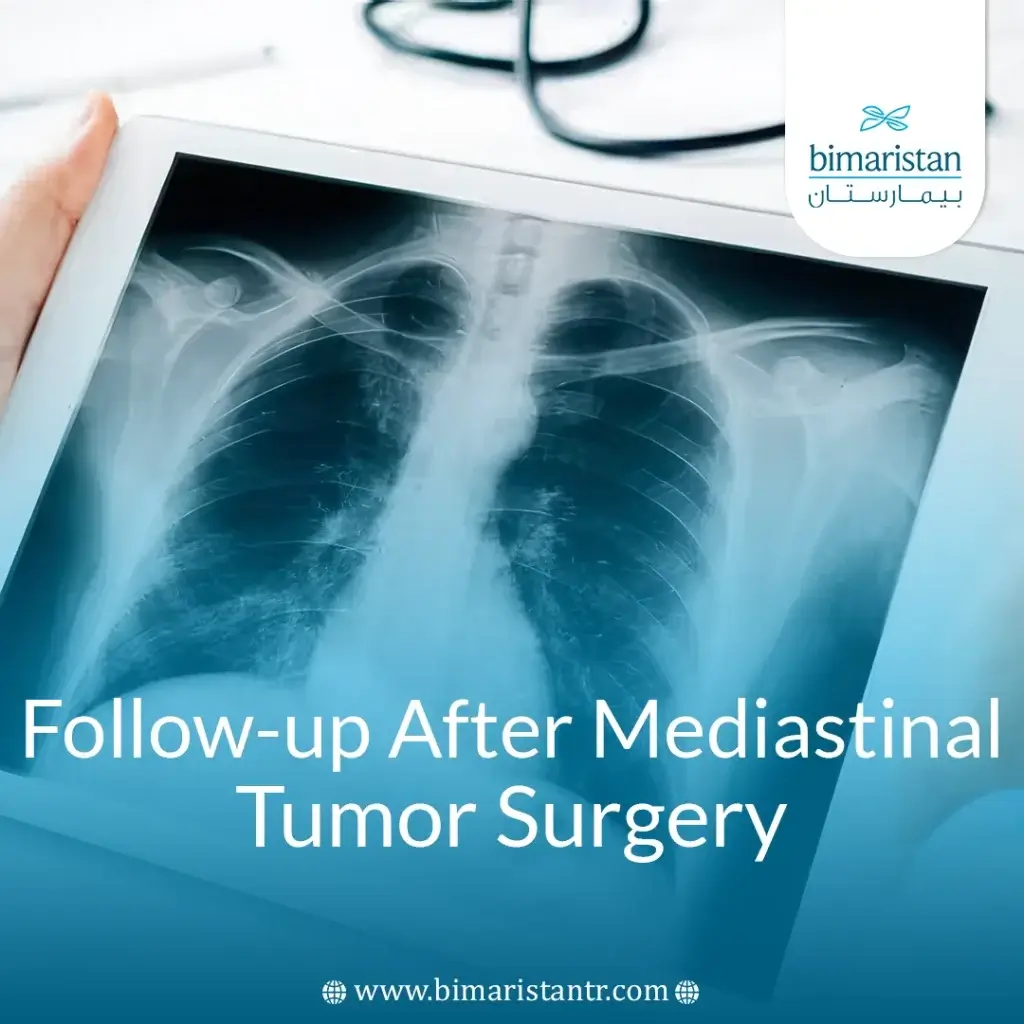After the surgical treatment of mediastinal tumors, some people think that the journey has reached its last stop, but the truth is that the most important stage starts from here: Careful and continuous follow-up after mediastinal tumor surgery to ensure full recovery and early detection of any possible tumor recurrence. In this article, we take you step by step through the post-operative journey to answer all your questions about post-mediastinal tumor removal and draw a clear roadmap towards reassurance and healing.
What are mediastinal tumors and why are they removed?
Mediastinal tumors are abnormal masses that arise in the mediastinum, a space in the middle of the chest between the lungs, which includes several vital organs, such as the heart, aorta, esophagus, trachea, thymus, and lymph nodes. These tumors may be benign (non-cancerous) or malignant (cancerous), and the most common types include: Thymomas, lymphomas, germ cell tumors, and cysts.
Although some of these tumors are benign, their removal is often necessary because they may grow and press on vital organs, leading to serious complications. For example, pressure on the trachea or lungs may cause breathing difficulties, while pressure on the heart may lead to disturbances in cardiac function, and injury to the esophagus may cause swallowing issues. In the case of malignant tumors, surgical removal becomes an essential part of the treatment plan, and sometimes even benign tumors are removed if they are large in size or located in positions that threaten the surrounding organs.
Therefore, early detection of these tumors plays a crucial role in preventing complications and achieving better treatment outcomes.
The importance of follow-up after mediastinal tumor surgery
Follow-up after mediastinal tumor surgery appointments is essential to ensure a safe and effective recovery. They enable the medical team to monitor healing progress, early detection of complications, and provide the necessary guidance to the patient at this critical stage of their health journey. Ignoring these appointments may lead to delayed healing, infections, or complications that could have been easily avoided. Here are the key aspects that highlight the importance of these appointments:
- Monitoring wound healing and recovery progress: During reviews, doctors examine the surgical site to make sure the wound is healing properly, watch for signs of infection such as redness, swelling, or discharge, and assess the body’s overall response to the surgery.
- Early detection of potential complications: Some complications, such as deep infection or blood clots, may not appear immediately after the procedure, so regular follow-up is an opportunity to detect these issues early, making them easier to treat and preventing them from worsening.
- Effective pain assessment and management: Pain is normal after surgery, but controlling it is essential to promote recovery. At each visit, the doctor assesses the level of pain and makes necessary adjustments to medications or offers alternatives that alleviate suffering without side effects.
- Review of prescribed medications: Follow-up appointments allow for an effective review of the medication plan, including checking dosages, making sure there are no unwanted side effects, and adjusting treatment as needed.
- Wound care and daily activity guidelines: Doctors provide precise advice on how to clean the wound and when the patient can gradually return to their daily activities without putting themselves at risk, including movement, exercise, and preventing clots.
- Respond to patient questions and concerns: Follow-up appointments are an opportunity for patients to voice their concerns, ask questions, and receive reassurance and guidance that will alleviate their anxiety and reinforce their commitment to their recovery plan.
- Reduce the need for re-hospitalization: Through early detection and treatment of any abnormalities, regular follow-up reduces the likelihood of repeat hospitalizations for preventable complications.
- Achieve a comprehensive and rapid recovery: Adhering to follow-up appointments speeds up the patient’s recovery and allows them to return to normal life efficiently and confidently.

Medical protocols in follow-up after mediastinal tumor surgery
Follow-up protocols are individually tailored according to the type and stage of the tumor and the overall health status of the patient. The main components of the follow-up:
- Clinical assessment: The doctor conducts periodic examinations to assess the patient’s general condition and note any worrisome symptoms such as persistent coughing, chest pain, or shortness of breath, which helps in detecting early signs of any abnormality or relapse.
- Radiography: Computed tomography (CT) or magnetic resonance imaging (MRI) are essential tools for detecting tumor recurrence or unresected tissue, the type and frequency of imaging is determined by the nature and stage of the tumor.
- Tumor biomarkers: For some types of tumors, such as germ cell tumors, measuring blood tumor markers such as AFP, β-hCG, and LDH is used to monitor the effectiveness of treatment and detect possible tumor recurrence
- Multidisciplinary care: An integrated team of surgeons, oncologists, radiologists, and pulmonologists provides a comprehensive and integrated approach to patient care
Symptoms to see a doctor at follow-up after mediastinal tumor surgery
After mediastinal tumor removal, some symptoms require immediate medical attention during follow-up after mediastinal tumor surgery:
- Fever: A fever of 38.3 degrees Celsius or higher indicates a possible infection and requires immediate medical evaluation.
- Severe chest pain: Severe or worsening chest pain should be treated, especially if it is accompanied by shortness of breath or other worrisome symptoms.
- Breathing difficulties: Any difficulty in breathing, shortness of breath, or wheezing should be reported to your doctor immediately.
- Swelling: Swelling in the chest, neck, or face, especially if accompanied by pain or difficulty swallowing, may indicate serious complications and require immediate medical attention.
- Signs of infection: Redness, warmth, or pus at the incision site are signs of infection and require immediate medical attention.
- Sudden change in voice: A sudden change in voice, especially hoarseness or difficulty speaking, may indicate nerve damage and should be evaluated by a doctor.
- Difficulty swallowing: Difficulty swallowing or pain while swallowing may indicate nerve or tissue damage and require medical attention.
- Heavy bleeding: Any heavy or persistent bleeding from the incision site or elsewhere should be reported to your doctor immediately.
Constipation: An inability to have a bowel movement for three or more days after surgery may be a sign of complications and requires medical advice. - Persistent cough: A cough that doesn’t get better or gets worse may indicate an issue with the lungs or airway.
- Swollen or painful lymph nodes: Swollen or painful lymph nodes, especially in the neck or chest area, may indicate that the tumor has returned or spread.
- Dizziness or headaches: Dizziness or headaches should be evaluated, especially if they are severe or persistent.
Does the patient need follow-up treatment after surgery?
The need for complementary treatment during follow-up after mediastinal tumor surgery depends on a number of factors, most notably the type and stage of the tumor and the extent of surgical resection, in addition to the presence of any residual disease or complications resulting from the surgery. In many cases, surgery is the primary treatment, but radiation or chemotherapy may be recommended in some cases, especially with malignant or advanced tumors.
Tumor type and stage
- Tumors of the thymus gland: Often treated with surgery as the first line of treatment, with the possibility of adding radiation therapy for advanced or incompletely resected tumors.
- Thymoma: A more aggressive tumor of the thymus that often requires combined treatment including surgery with radiation or chemotherapy.
- Germ cell tumors: Non-seminomas are more responsive to chemotherapy, which is the first choice. Surgery is used in some cases and may be followed by adjuvant chemotherapy depending on clinical indications.
Completeness of surgical resection
- Complete resection (R0): When the entire tumor is removed, especially in benign or malignant tumors in the early stages, there may be no need for adjuvant therapy.
- For incomplete resection (R1 or R2): If microscopic or visible cancer cells remain, radiation or chemotherapy is often recommended to minimize the risk of relapse.
Presence of residual disease or complications
- Increased tumor markers after surgery may indicate residual cancerous tissue and require additional treatment.
- Tumor recurrence (relapse) requires a new treatment intervention that may include additional surgery, radiation, or chemotherapy.
- Surgical complications such as infection or bleeding may require supportive or therapeutic interventions depending on the situation.
Possible complications after ablation and how to deal with them
Although surgery for mediastinal tumors is a pivotal step in treatment, it can come with a host of potential complications that require proactive preparation and careful follow-up after mediastinal tumor surgery, including:
- Respiratory issues: These include pneumonia, airway obstruction due to swelling or pressure, and injury to the phrenic nerve, which can impair the ability to breathe.
- Bleeding: This may occur as a result of technical issues during surgery or blood clotting disorders and may require urgent intervention or surgical re-exploration.
- Blood clots: This includes deep vein thrombosis (DVT) or pulmonary embolism (PE), two serious complications that require prevention and early mobilization.
- Infection: Signs include fever, chills, and pain or redness at the wound site and require antibiotic treatment and close monitoring.
- Nerve damage: In addition to the phrenic nerve, other nerves may be damaged, leading to symptoms such as hoarseness or difficulty swallowing.
- Pain and fatigue: These are persistent symptoms after surgery, and some pain may last for months, requiring proper treatment and follow-up.
- Superior vena cava syndrome (SVC): Caused by compression of the vein, SVC causes swelling of the face and upper extremities with shortness of breath and requires rapid intervention.
Mediastinal tumor surgery is a pivotal step in the treatment process, but true success is not limited to the procedure alone, but extends to the post-operative care, regular follow-up after mediastinal tumor surgery, and thorough evaluation of any potential complications. By understanding the nature of the tumor, determining the need for complementary therapy, and preparing for post-operative challenges, the chances of recovery can be improved and the risks significantly reduced.
Sources:

